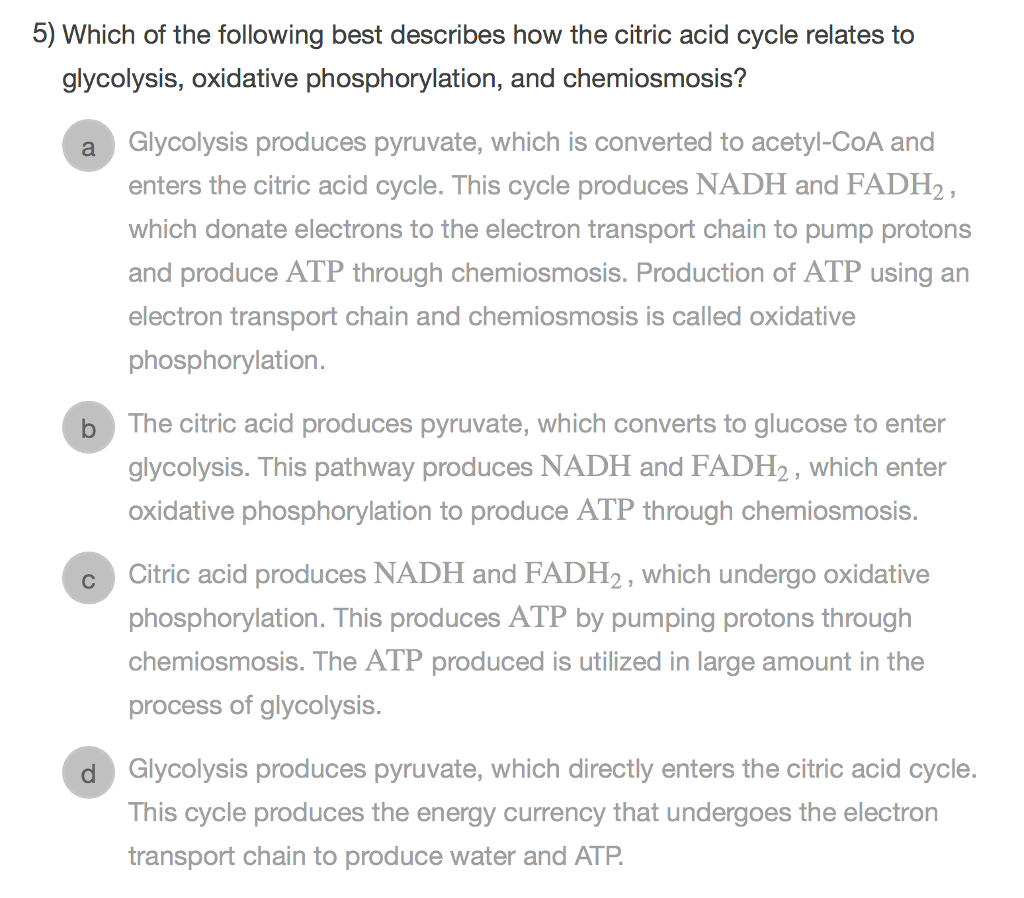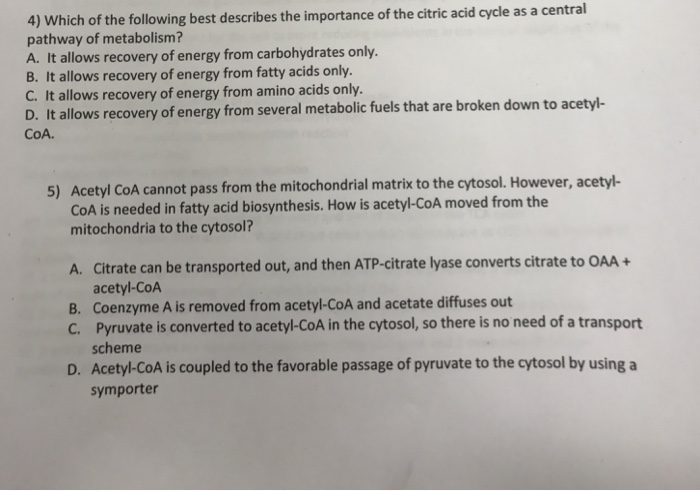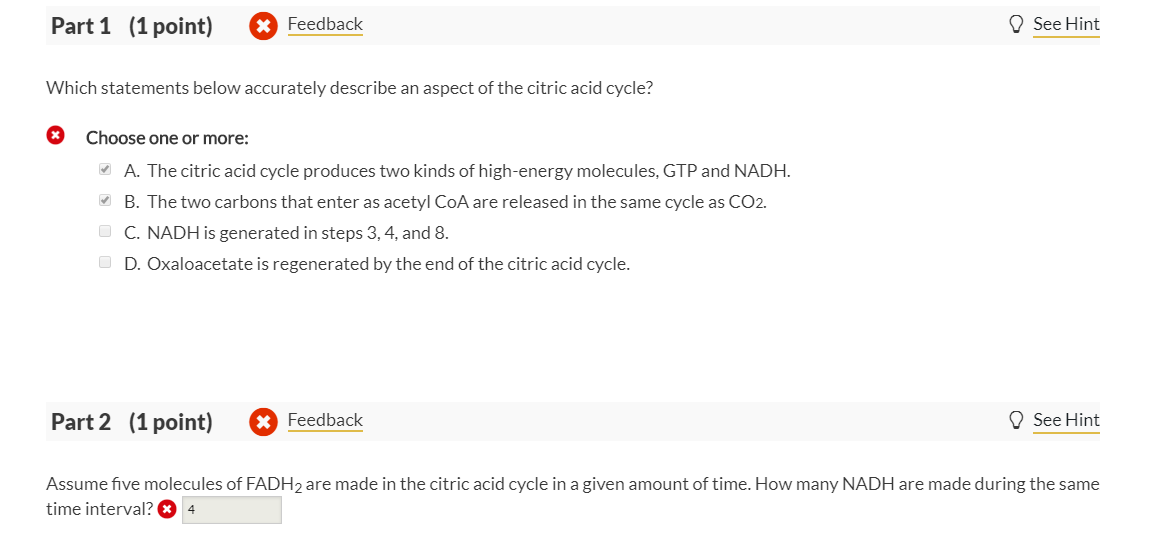What Best Describes the Citric Acid Cycle
This cycle produces NADHNADH and FADH2FADH2 which donate electrons to the electron transport chain to pump protons and produce ATPATP through chemiosmosis. This cycle produces NADH and FADH _2 which donate electrons to the electron transport chain to pump protons and produce.

Solved Which Statement Describes The Citric Acid Cycle This Chegg Com
This process joins 2 pyruvic acid molecules into a molecule of glucose.

. Glycolysis produces pyruvate which is converted to acetyl-CoA and enters the citric acid cycle. O A The citric acid produces pyruvate which converts to glucose to enter glycolysis. Biology questions and answers.
In the case of a person who consumes a normal balanced diet proteins are essential to the body for all of the following EXCEPT _____. The function of glycolysis is to begin catabolism by breaking glucose into two molecules of pyruvate with a net yield of two ATP. It finishes the sugar-breaking job started in glycolysis and fuels the production of ATP in the process.
It allows recovery of energy from fatty acids only C. Breakdown of glucose to two molecules of pyruvate d. Which of the below best describes the citric acid cycle.
The citric acid cycle also known as the Krebs cycle or the tricarboxylic acid cycle is at the center of cellular metabolism playing a starring role in both the process of energy production and biosynthesis. Which of the following statements best describes the primary role played by oxygen in cellular respiration. Researchers suspect that early methods for converting pyruvate to.
Which answer best describes the role of telomerase in replicating the ends of liner chromosomes. Which of the following best describes how the citric acid cycle relates to glycolysis oxidative phosphorylation and chemiosmosis. Which of the following best describes how the citric acid cycle relates to glycolysis oxidative phosphorylation and chemiosmosis.
Which statement describes the citric acid cycle. The citric acid cycle. The TCA cycle also known as the citric acid cycle or Krebs cycle occurs in the mitochondria and provides large amounts of energy in aerobic conditions by donating electrons to three NADH and one FADH flavin adenine dinucleotide which donate electrons to the electron transport chain creating the proton gradient.
This cycle produces NADH and FADH _2 which donate electrons to the electron transport chain to pump protons. Through the next steps of the cycle two of the six carbons of the citric acid leave as carbon dioxide to ultimately yield the four carbon product. The last part of.
Glycolysis produces pyruvate which is converted to acetyl-CoA and enters the citric acid cycle. Which of the following statements best describes complete protein. 1It serves as an acceptor for carbon forming CO2 in the citric acid cycle.
Which of the following best describes how the citric acid cycle relates to glycolysis oxidative phosphorylation and chemiosmosis. Yes the citric acid cycle has the same citric acid. The Krebs cycle or Citric acid cycle is a series of enzyme catalysed reactions occurring in the mitochondrial matrix where acetyl-CoA is oxidised to form carbon dioxide and coenzymes are reduced which generate ATP in the electron transport chain.
Researchers suspect that the original citric acid cycle was used by all species. The citric acid cycle is a closed loop. Glycolysis produces pyruvate which is converted to acetyl-CoA and enters the citric acid cycle.
Must contain all the bodys amino acid requirements for tissue. 4 Which of the following best describes the importance of the citric acid cycle as a central pathway of metabolism. Krebs cycle was named after Hans Krebs who postulated the detailed cycle.
It catalyzes the lengthening of telomeres compensating for the shortening that could occur during replication. In eukaryotes the citric acid cycle takes place in the matrix of the mitochondria just like the conversion of pyruvate to acetyl. The formation of glucose de-novo from other molecules O b.
We are now ready to begin going through the reactions of the citric acid cycle. This cycle produces NADH and FADH2 which donate electrons to the electron transport chain to pump protons and produce ATP through chemiosmosisProduction of ATP using an electron transport chain and chemiosmosis is called oxidative phosphorylation. It loses a hydrogen atom and loses potential energy.
Although the citric acid cycle itself does not use O 2 it requires a functioning electron-transport chain which uses O 2 in order to regenerate which molecule for further use in the citric acid cycle. This pathway produces NADH and FADH2 which enter through chemiosmosis. In prokaryotes these steps both take place in the cytoplasm.
Researchers suspect that portions of the reverse cycle may have been responsible for fixing CO2. The function of the citric acid cycle is the transfer of electrons from pyruvate to NADH to O2. 3 The citric acid cycle depends on the availability of NAD which is a product of glycolysis.
Only in the citric acid cycle. The Reactions of the Citric Acid Cycle. 2It serves as the final acceptor for electrons from the electron transport chain.
The citric acid cycle also known as the Krebs cycle or tricarboxylic acid TCA cycle is a series of chemical reactions in the cell that breaks down food molecules into carbon dioxide water and energy. View the full answer. 3It yields energy in the form of ATP as it is passed down the electron transport chain.
Which statement describes the citric acid cycle. The cycle begins with the reaction between acetyl-CoA and the four-carbon oxaloacetate to form six-carbon citric acid. The citric acid cycle oxidizes glucose to carbon dioxide.
Transfer of energy via electrons in a series of oxidation-reduction reactions to make ATP c. In plants and animals eukaryotes these reactions take place in the matrix of the mitochondria of the cell as part of cellular respiration. It allows recovery of energy from carbohydrates only B.
Which statement best describes how the citric acid cycle relates to glycolysis oxidative phosphorylation and chemiosmosis. This process uses energy captured from electrons flowing to oxygen to produce most of the ATPs in cellular respiration. It allows recovery of energy from amino acids only.
The citric acid cycle also known as the Krebs Cycle is actually a part of the much larger process called cellular respiration the process where your body harvests energy from the food you eat. The citric acid cycle also known as the Krebs cycle or tricarboxylic acid TCA cycle is the second stage of cellular respirationThis cycle is catalyzed by several enzymes and is named in honor of the British scientist Hans Krebs who identified the series of steps involved in the citric acid cycle. In both gylcolysis and citric acid cycle D.
Which statement describes the citric acid cycle. 2 The citric acid cycle produces most of the ATP that is subsequently used by the electron transport chain. Many bacteria perform the.
This process splits glucose in half and produces 2 ATPs for each glucose. This process produces some.

Solved 5 Which Of The Following Best Describes How The Chegg Com

Solved 4 Which Of The Following Best Describes The Chegg Com

Solved Part 1 1 Point Feedback See Hint Which Statements Chegg Com
No comments for "What Best Describes the Citric Acid Cycle"
Post a Comment